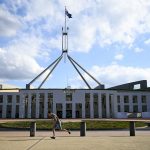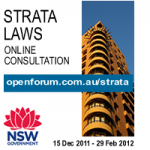Coalition victory not inevitable
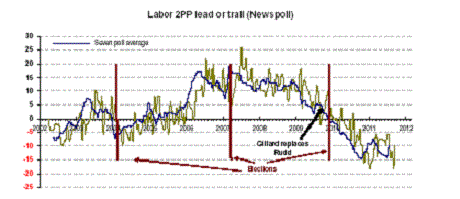
If you are to believe media reports and political polls it’s seemingly inevitable that we will have a change of government at the next federal election. But Ian McAuley doesn’t accept it’s the forgone conclusion many are predicting.
Over the last year there has developed an assumption that the 2013 election will see a clear victory by a Coalition Government headed by Tony Abbott.
While acknowledging the strong probability of such an outcome, I want to cast some scepticism on the strength of that assumption, by addressing these questions: Which party will win the next federal election, who will be Prime Minister after the next election, what will economic policy be after the next election, and which party will win the next federal election?
Opinion polls are volatile, but they too show a strong Coalition lead. The Pollytics Pollytrend which smooths all polls, has the June 2012 two party preferred (2PP) support for Labor at 44 percent. (Coalition at 56 percent.)
That’s a snapshot. Looking at poll movements over time, using Newspoll data and filtering out most of the noise, there have been two strong movements in recent years:
- from November 2005 to January 2007, a rise in Labor’s 2PP vote of 17 percent – about 1.2 percent a month;
- from July 2009 to June 2011 a fall in Labor’s 2PP vote of 29 percent – about 2.6 percent a month. (Note that the changeover to Gillard as leader simply saw this fall continue.)
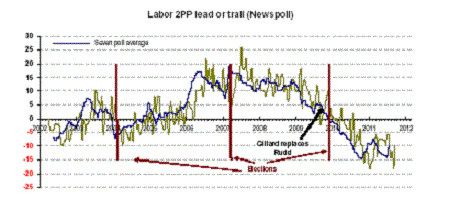
Assuming there will be an election in August 2013, to recover to a zero 2PP position Labor’s 2PP support would need to pick up 6 percent, a move of 0.4 percent a month.
- the damage of the Thompson and Slipper affairs has already been absorbed;
- the success of the Coalition in state elections is likely to result in some people casting a “balancing” vote federally;
- the carbon price is more costly in expectation than it will be in realisation (the acceptance of the GST is illustrative in this regard);
- the Coalition will be pressured to reveal more of its policies;
- generally gaps close as an election approaches (although this was not observed in the NSW and Queensland elections).
I won’t come entirely off the fence, but I will put one foot into the Coalition’s paddock. In my view a Coalition victory is likely, but I wouldn’t be willing to take the betting agencies’ odds for the Coalition – it is far less assured in my opinion.
Who will be Prime Minister after the next election?
For those concerned with policy, this is a more interesting question. Australia is in a politically extraordinary situation:
- The government is short of a majority in the House of Representatives.
- Both the Prime Minister and Opposition Leader have very low personal poll ratings, which are essentially equal (small leads by one or the other are within the range of statistical error). And both score equally on “better prime minister”, although the trend on this score is away from Abbott.
- Both the Prime Minister and the Opposition Leader trail other potential leadership candidates in their own parties.
- There is a contrast between the government’s popularity (negative as measured by the 2PP figures and even lower on a primary vote basis) and the public preference for significant Government policies which the Opposition promises to overturn. Apart from the carbon price, the Government’s practical policies are preferred to those of the Coalition.
This all makes for a degree of instability in leadership, and leadership changes on either side could lead to a significant move in the polls. I stress that such moves are likely to be reasonably short-term – leadership changes may result in a “honeymoon” effect, but they don’t seem to break trends. They may have some effect, however, if they are not too far from an election. (The most famous such move was in 1983 when Hawke replaced Hayden a month before an election and went on to win.)
I have drawn up a contingency table of paths to election outcomes, with the starting point being the opinion poll results for the remainder of this year. A significant shift in polls can result in changes in party leaders, and there are three exhaustive ways the polls can go:
- A sustained recovery in Labor’s 2PP vote.
- A continuation of the present ten percent or so trail.
- A resumption of the fall.
Most political pundits suggest that (3) would be followed by a change in the Labor leadership. A subsequent possibility is a change in Liberal leadership, particularly if Labor’s leadership change were to produce a very sharp lift in its support.
A sustained recovery, particularly if Labor’s 2PP vote reached striking distance of victory (perhaps a four point rise to 48 percent) could trigger a leadership change in the Liberal Party. That, in turn, could trigger a change in the Labor leadership if the Liberal Party change led to a Election Report 2013 3 significant reversal in Labor’s fortunes. (Paradoxically, it is not necessarily in the Prime Minister’s personal interests for her Party to make too strong a recovery, particularly while her personal approval rating is low.)
The contingency table shows six possible outcomes, three of which deliver a near-certain Coalition victory, two of which are indeterminate, and one of which delivers a near-certain Labor victory.
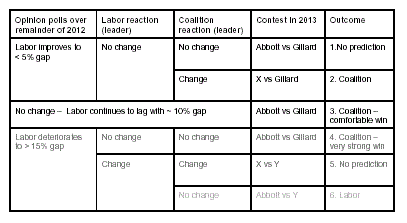
The first three scenarios I see as more likely than the last three, because for the reasons stated above, I don’t see a further fall in Labor support as likely. The sixth scenario, which would involve the Liberal Party retaining Abbott while Labor fields a popular leader, I see as very unlikely.
Also I have not included the possibility of one other scenario: Labor’s position improves; Liberals appoint a new leader in response; the Labor lead is eliminated; Labor replaces its leader, resulting in an X vs Y election. The first parts of this scenario are plausible, but it would be very unusual for any party to punish polling success. Two of the three more probable scenarios lead to an almost certain Coalition victory, but only one of them leads to a clear Abbott victory.
These scenarios don’t include those which may trigger an early election, which would almost certainly lead to a Coalition victory. But again there is no certainty that such a Coalition would be led by Abbott. One scenario, which most pundits see as possible, is that Labor will lose crucial seats and be forced to an election. Another, however, is that the Liberal Party may do a deal with key independents to get their pledged support for a leader other than Abbott. It should be remembered that the independents, generally, have sided with Gillard because of their clear
hostility to Abbott, not hostility to the Liberal Party.
What will economic policy be after the next election?
A more interesting question than “what party will form the next government”, is “what will be the economic policy of the government to be elected late next year?” That is relevant for those concerned with public policy.
Abbott has not announced any specific economic policy, but from his statements the observer can put one together, for they include cuts in taxes, increases in welfare, and a commitment to balanced budgets. That can only mean deep cuts in government programs other than transfer payments. That means cuts in health care, education, infrastructure etc. It’s essentially a return to the Howard policy, but without the strong revenue stream to maintain even the quite low government “own purpose” expenditure which was sustained under the Howard Government.
But the extent to which Abbott is in control of economic policy is not clear. He is facing strong challenges in his own Party over his welfare promises, most prominently from Hockey.
Other economic tensions within the Coalition relate to environmental policy (direct action vs market mechanisms), wages policy, industry protection and foreign investment policy. (Many of these come from National-Liberal differences.)
Other uncertainties relate to the nature of a possible Coalition victory. A Coalition victory in the House of Representatives without a victory in the Senate could result either in pragmatic stability (as was the case with the Howard Government until it won a Senate controlling interest), or a “crash through” approach, as is hinted by Abbott.
A decisive Coalition victory would probably produce a controlling majority in the Senate, but, as has happened in NSW, it could also produce a strong group of newly-elected members representing traditional “Labor” constituencies, exercising enough Caucus control to influence important policies (e.g. directing infrastructure and education spending to outer suburban electorates.)
Overall, as mentioned above, there is a reasonably strong preference for Labor’s economic policies over those of the Coalition. In response a Coalition government, seeing survival as more important than ideology, could either take on those policies as its own (as the Menzies Government often did), or could try to crash through with a strong agenda – a mirror-image of the Whitlam years, even probably including a double dissolution!
Conclusion
My conclusion (morning, June 21) is:
- A Coalition victory at the next election is more probable than a Labor victory, but not with the certainty that many people tend to hold.
- An Abbot victory is less likely than a Coalition victory. This may read like a self-evident statement of the specific being less likely than the general (the disjunctive rule), but I believe it is significantly less likely.
- It is nearly impossible to predict what economic policy would prevail in a Coalition Government.
That third point is important. In most democracies elections do not produce radical shifts in policies. Australia, with its strong Westminster traditions, is something of an exception, but even here for the most part there has been commitment to certain basics, such as the concept of a “social wage” as set out in the 1945 White Paper on Full Employment, a document prepared by a Labor Government, but which guided successive governments for at least fifty years. There is no similar base for the 21st Century.
Ian McAuley is an Adjunct Lecturer in Public Finance, University of Canberra. One of his main concerns is to improve understanding of economic issues among welfare and consumer groups. For more information visit his website.
Ian McAuley is a retired lecturer in public sector finance at the University of Canberra and a fellow of the Centre for Policy Development. He has been involved in many aspects of the work of Global Access Partners and its ‘Second Track’ Process.







